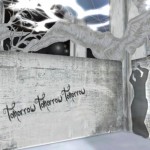Posts tagged Game based learning
Thoughts on Student Safety and Using OpenSim for Education
1OpenSim is making headway as a viable alternative to Second Life. About 98% of the functionality of Second Life is present in OpenSim. The remaining 2% primarily deals with vehicle physics. Although it is still considered “alpha” software, OpenSim hosting is sold, and teachers, students, and businesses are taking advantage. The alpha status reflects more on the rapidly changing nature of the virtual world market, than the stability of the software itself. Microsoft and IBM have some backing in it. Intel operates its ScienceSim experiments with OpenSim, and has made headway in providing models for ubiquitous shareable content and massive user connections.
There are definitely some measures being taken to address educators’ needs. The Jokaydia and 3rd Rock Grids have been around for several years, and they are largely education-oriented. Last year, Firesabre launched its own Starlight Grid, which provides private hosting for educators. And Kitely is starting to establish itself as the premiere third-party choice for educators, and provides the option for making user-created regions private. However, as hypergridding becomes more stable and common, this can be the vehicle to unite different grids into a single education-related hypergrid. The common “education hypergrid” should blend the most relevant content for students and teachers into a singularly accessible virtual space. There should never be any reason for a teacher or student to log out of their viewer and log back into another grid with a whole new avatar. But we need to think about how to make such a hypergrid suitable for students, especially K-12 since there’s often a litany of additional laws and policies governing online interactions and access for them.
A few thoughts and ideas come to mind:
- It is more productive to include students rather than solely use teachers to create content. Many teachers already do this, since with their often beyond-full-time jobs they simply don’t have the time to both learn the skills needed for building in a virtual world, and actually construct the content alone. We should use the skills of the young tech-savvy generation, and develop constructionist class projects that appeal to our students.
- Activities should directly tie in with the curriculum. This is rather obvious, but it would be useful if virtual world activities were tagged with the relevant standards and/or objectives they address. This way, others in the same state, province, or country can find relevant material, without having to wonder if it actually addresses the necessary learning content or is just another topical sim.
- To address safety issues, different approaches have been taken. I mentioned above how FireSabre and Kitely provide private regions. For educators, they don’t want inappropriate content to drift in, or outside trolls to visit the region and cause havoc while students are using it. While securing a sim for exclusive private access is well-intentioned, they miss out on the community-produced educational content. Whether this is on Second Life, OSGrid, or any other virtual world system, a significant strength of the virtual world is in its shared content. We should avoid having to recreate the wheel each time.
- One solution could be to script a session monitor. Those who wish to join the education hypergrid can be required to place a script inside each region which connects to a server and monitors participants. Teachers who wish to use a particular region (or group of regions) for learning but are worried about others coming in and disrupting the class can reserve a session, and either enter their students’ avatar names, or have the students sign up themselves. The script would monitor anyone entering or currently in the region and kick out anyone not registered for the session. A publicly viewable calendar in the regions and on the web would let others know what time slots are open.
- We need to provide a venue for coordinating with educators and organizations who are considering investing actual time or money in the development of a sim. If similar goals and objectives can be identified, pooling resources together may help alleviate the burden for all parties involved.
-

Regions such as the "Foul Whisperings, Strange Matters" Macbeth sim in Second Life could be added to an educator-maintained whitelist so the viewer knows it's student-appropriate
One solution to the problem of inappropriate content and the ability to provide a safe gateway to Second Life for students 16+ may be to build a custom viewer that uses whitelists. Ideally based on Viewer 2/3 (e.g. Kokua and Firestorm are two viewers being developed off this branch), it would access a server-maintained whitelist of regions appropriate for students. Anything not on the whitelist would not be accessible from the viewer. This can cross over to OpenSim as well. Though some regions on different grids may be “education-appropriate” and suitable to be hyperlinked to, other regions may not be. A mechanism in the viewer could prevent teleporting to regions that aren’t specifically part of the education hypergrid. This doesn’t prevent the usage of other viewers from bypassing these client security measures, but it’s still one measure that could help, and may meet the security policies of many schools and districts. Another option is to implement a teleport-restricting module on the server side so it limits access to educational regions, but since OpenSim is still in alpha, requiring it be included in all upgrades may be inconducive, unless a separate fork of OpenSim is made (much like OSGrid or Diva Distro). - When appropriate, content should be Creative Commons-licensed. This isn’t entirely necessary, and I believe there is tremendous value in reinforcing the commercial OpenSim goods market. But any CC content could be provided as OARs and IARs (compressed archives of OpenSim content), so it can be installed on private servers. Direct links to OARs and IARs should be posted inside the regions themselves, when possible.
- We should create an open, zero-cost (for the end user) conference region. This can be accessed from anywhere in the hypergrid, and can be reserved for school events or professional development as needed.
Hopefully I’m not too far off base with some of these thoughts. I believe as we move forward it will become increasingly important to standardize how educational simulations are maintained so they can meet the policies and safety standards of most school systems.
This article was reprinted in Hypergrid Business.
Engaging Learners Through Video Game Principles
1In a TED Talk from 2010, Tom Chatfield describes seven aspects that lend to the creation of effective, engaging games. They can particularly be applied to how we learn in general. The video is shown below, and he starts describing the seven aspects around the 8:30 mark.
These ideas apply directly to how learning-oriented games can be designed, and to a large degree apply to the physical classroom environment as well. Chatfield’s list is as follows:
1. Experience bars measuring progress
Instead of assigning grades, some teachers have turned to an experience point system. This is a familiar aspect of games, and measures a student’s steady progression through tasks (or “quests”). This system can apply to traditional classroom learning as well, and a teacher could accomplish this by putting experience bars up on a board, or manage it with online student profiles. Experience points are great at measuring progress over time in a nuanced, quantified manner, perhaps moreso than a flat list of assignments on a student’s progress report can do.
2. Multiple long and short-term aims
Students should be allowed to participate and choose different types of quests. Different quests can lead to larger goals, but students should be allowed to guide their progress, and take ownership of what they choose to accomplish. With enough “subquests,” students feel as though they are continually progressing, and have a clear end in sight.
3. Reward for effort
This goes back to standard behaviorist principles. If desired behavior is rewarded, the behavior will be reinforced and more likely to be repeated. We shouldn’t punish students when they fail, but instead recognize their achievements as they learn. Games teach us that we should turn “failure” into “success not yet realized.”
4. Rapid, frequent, clear feedback
One of the advantages of games is that they allow players to link consequences to actions. Even in cases where a game’s storyline is progressive and linear, a clear cause-and-effect chain is implied. For open-ended games, the player can alter the state of the world through their own choices. It is essential to learning that students are given prompt feedback following activities, so they know if their attempt was successful, or what could have caused unintended outcomes.
5. An element of uncertainty
People should not always expect everything, and the consequences or outcomes should not always be expected. This adds to excitement and encourages people to keep coming back. When applied to education, it keeps students entertained and willing to keep engaging in the learning process.
6. Windows of enhanced attention
Find moments in a learner’s play where they will be most receptive to learning, and identify areas where learners will gain confidence as they play. This can relate to how Kiili (2005) describes flow theory, or the ideal state at which a participant is absorbed in the learning material, the optimal experience in which full attention is placed on the activity, and nothing else seems to matter. If we can create these types of experiences in our games, students will be more receptive to what is being taught.
7. Other people
Students will invariably possess different competency levels in any game they play, and as they learn, their skills will evolve at varying speeds. Hunicke (2005) discusses this at length as a mechanism for creating an effective gaming environment without disrupting player experience. A balance must be formed between the game’s ease and difficulty. In other words, the game must be “gamed” in such a way that learners are not bored or frustrated with the ease or difficulty.
References
Hunicke, R. (2005). The case for dynamic difficulty adjustment in games. Proceedings of the 2005 ACM SIGCHI International Conference on Advances in Computer Entertainment Technology, 429-433.
Kiili, K. (2005). Digital game-based learning: Towards an experiential gaming model. The Internet and Higher Education, 8(1), 13-24.


